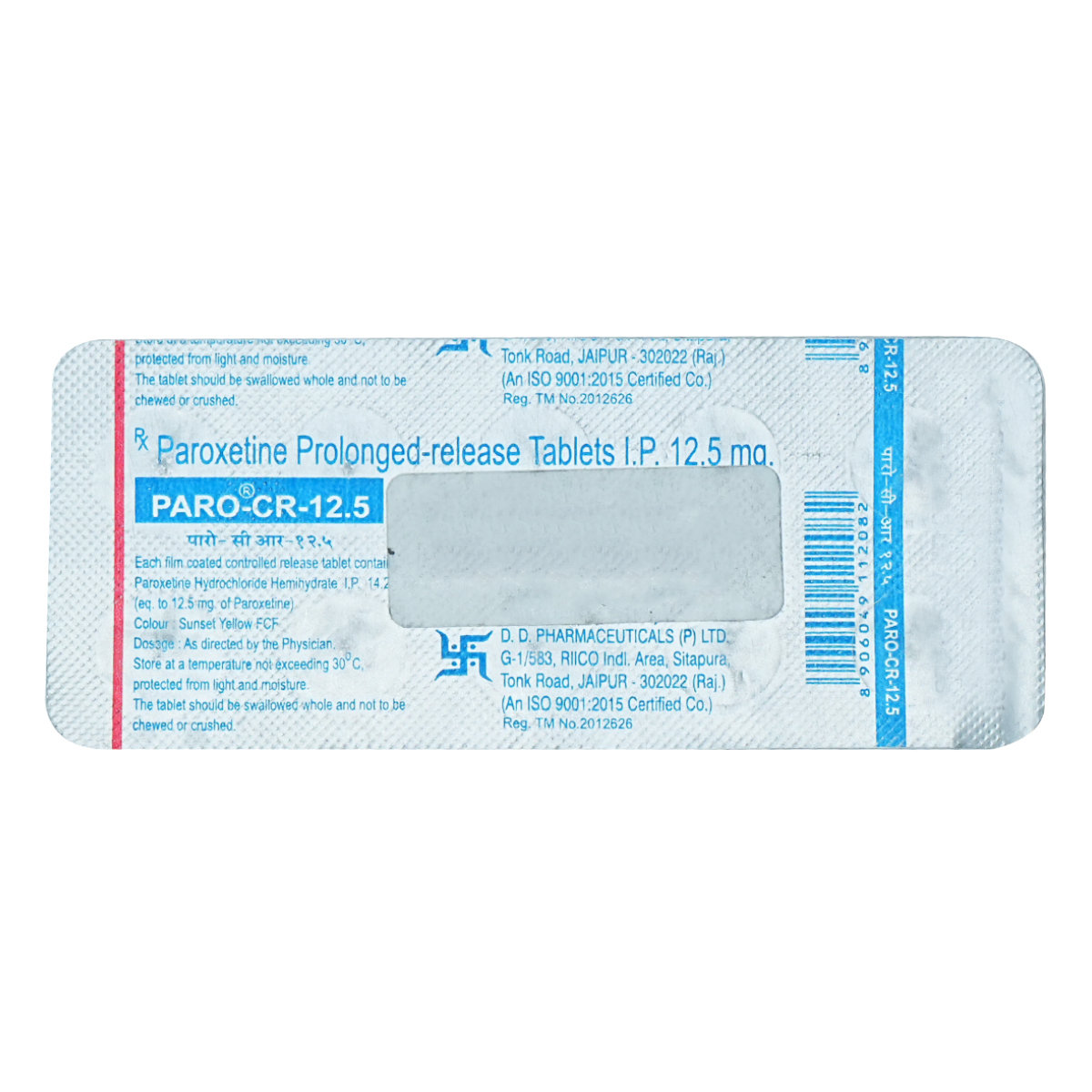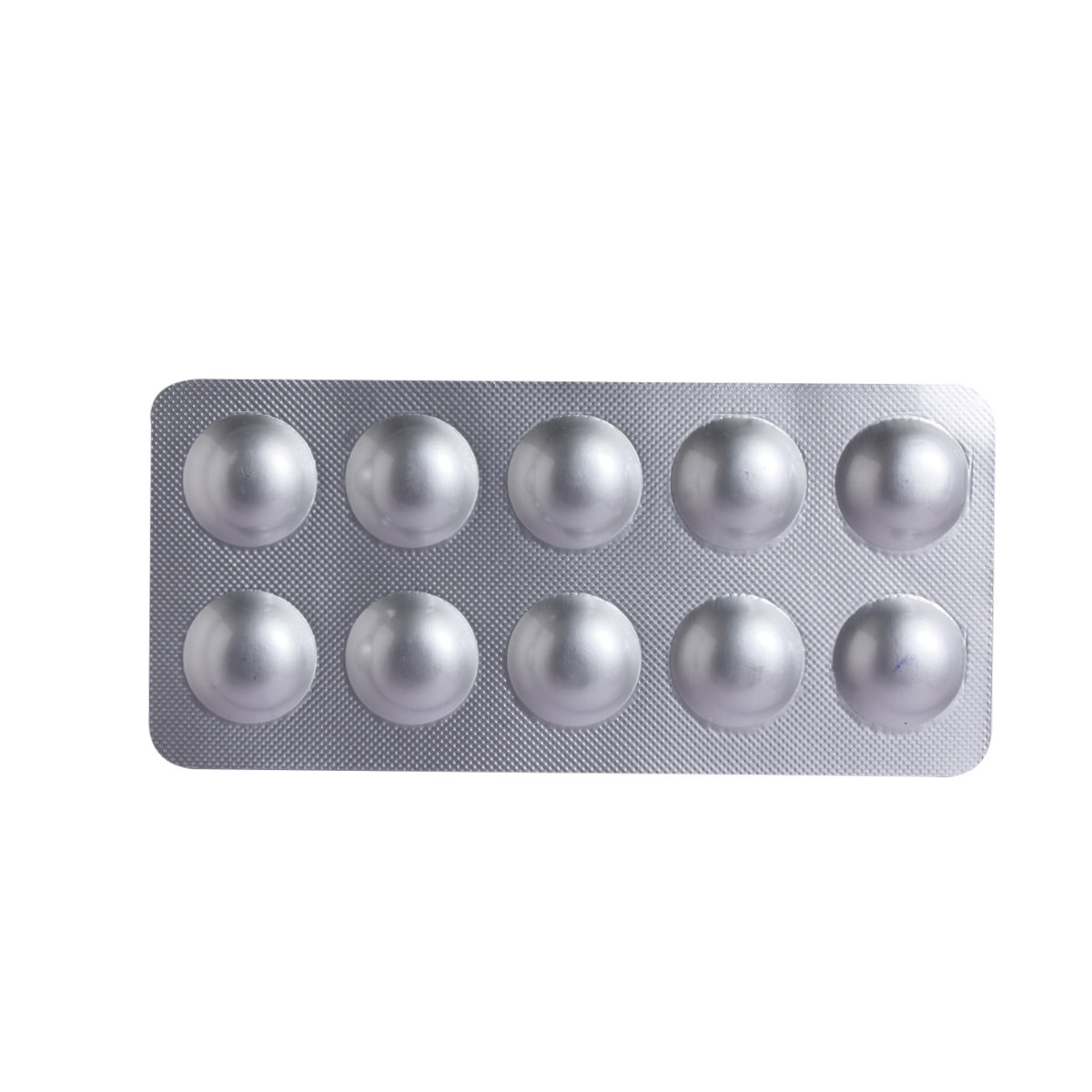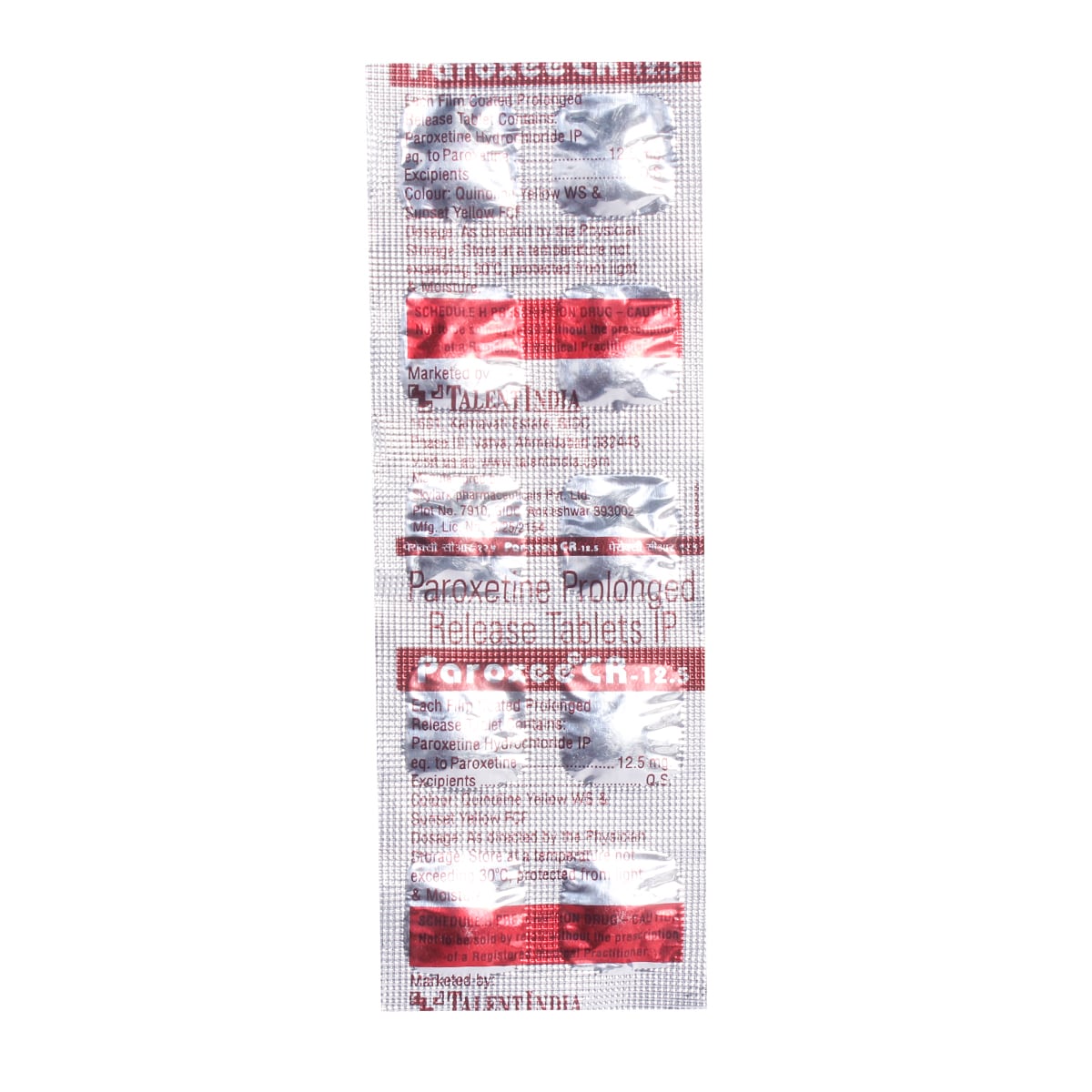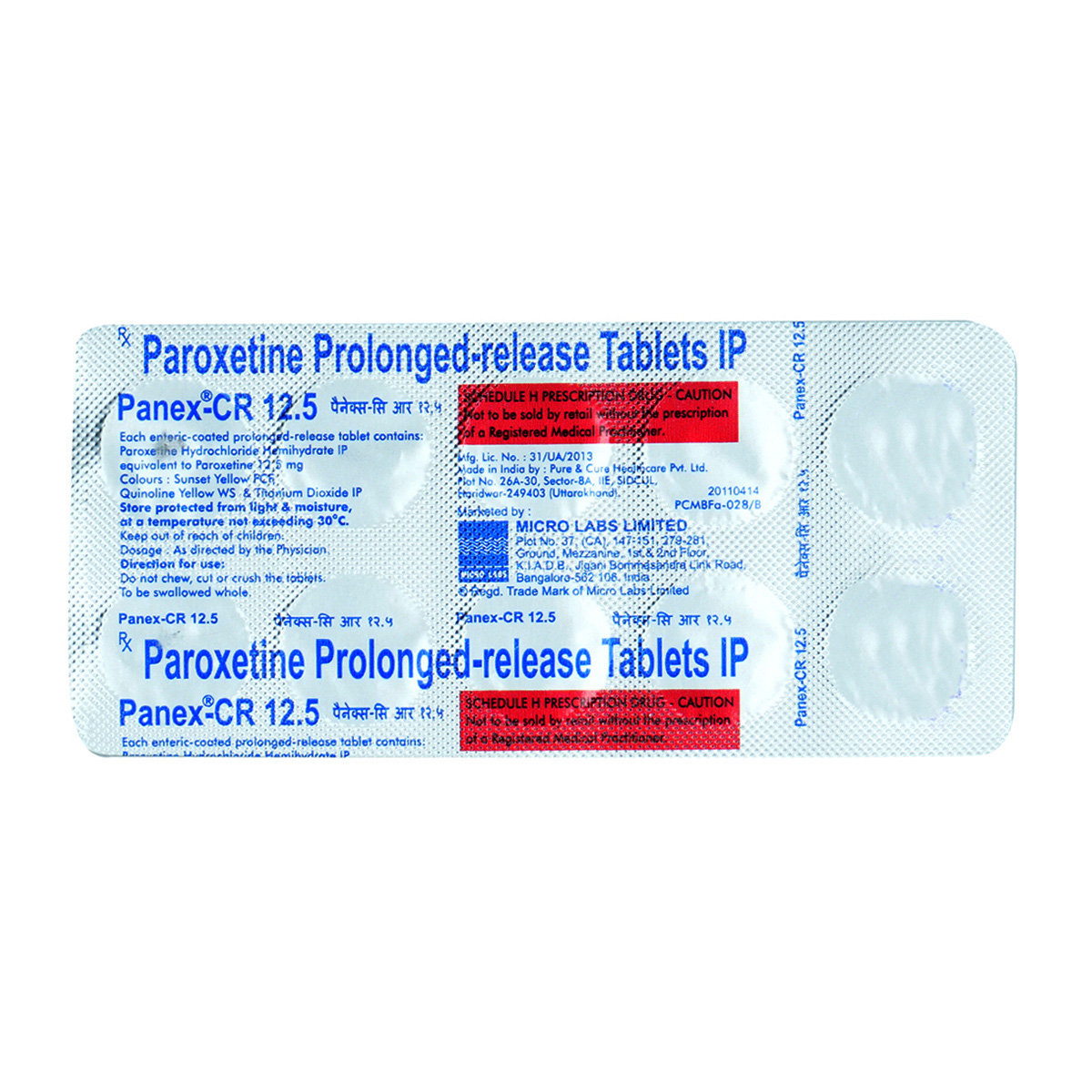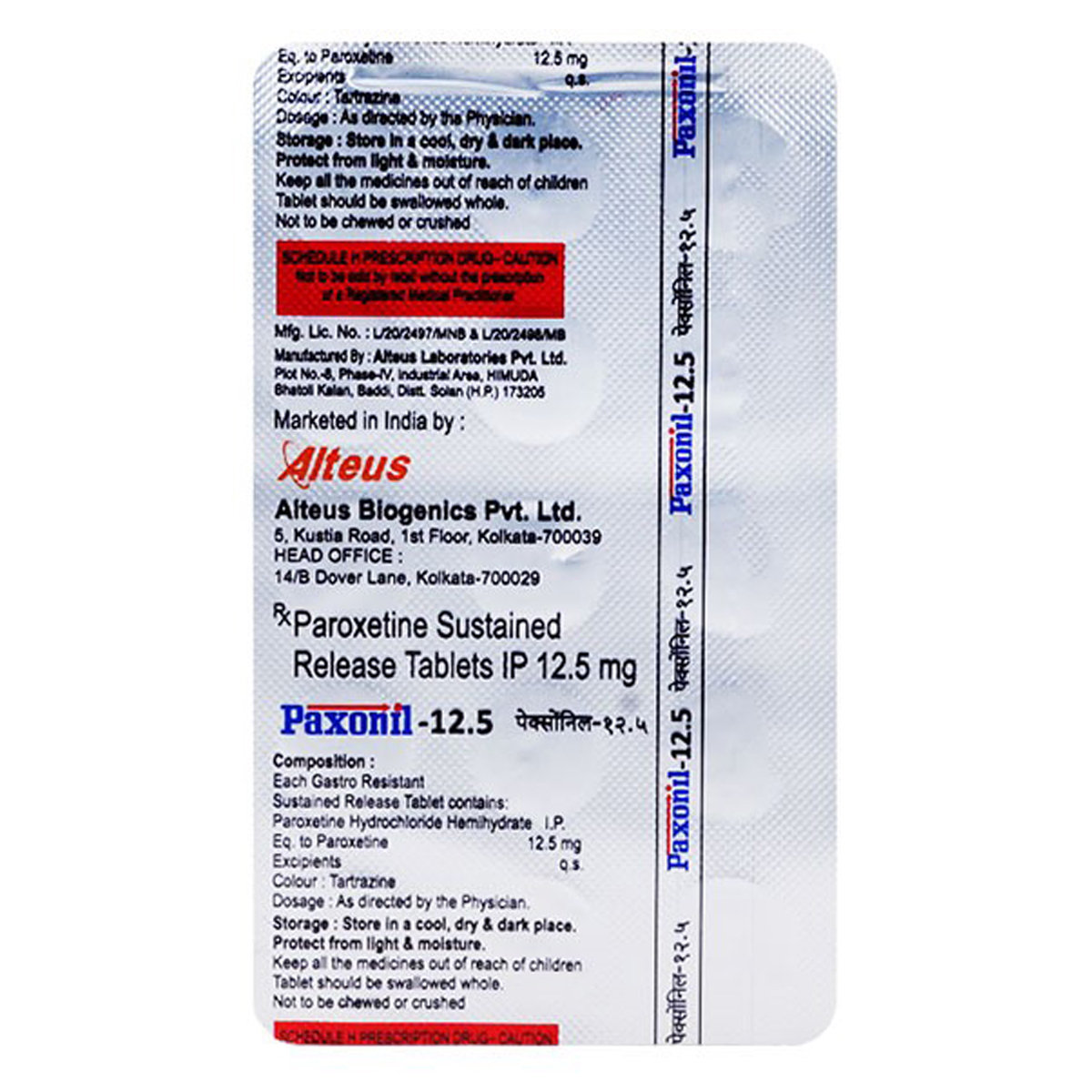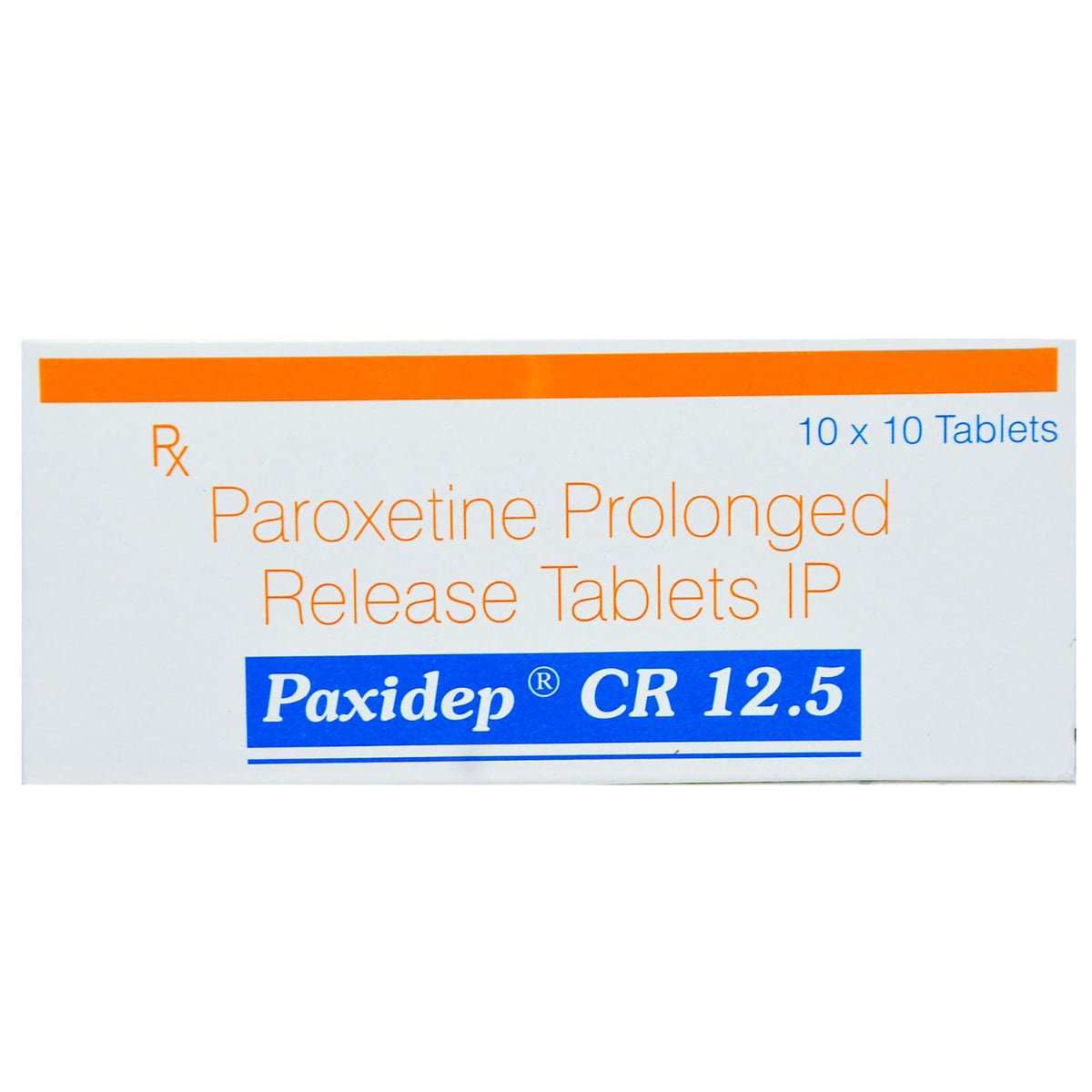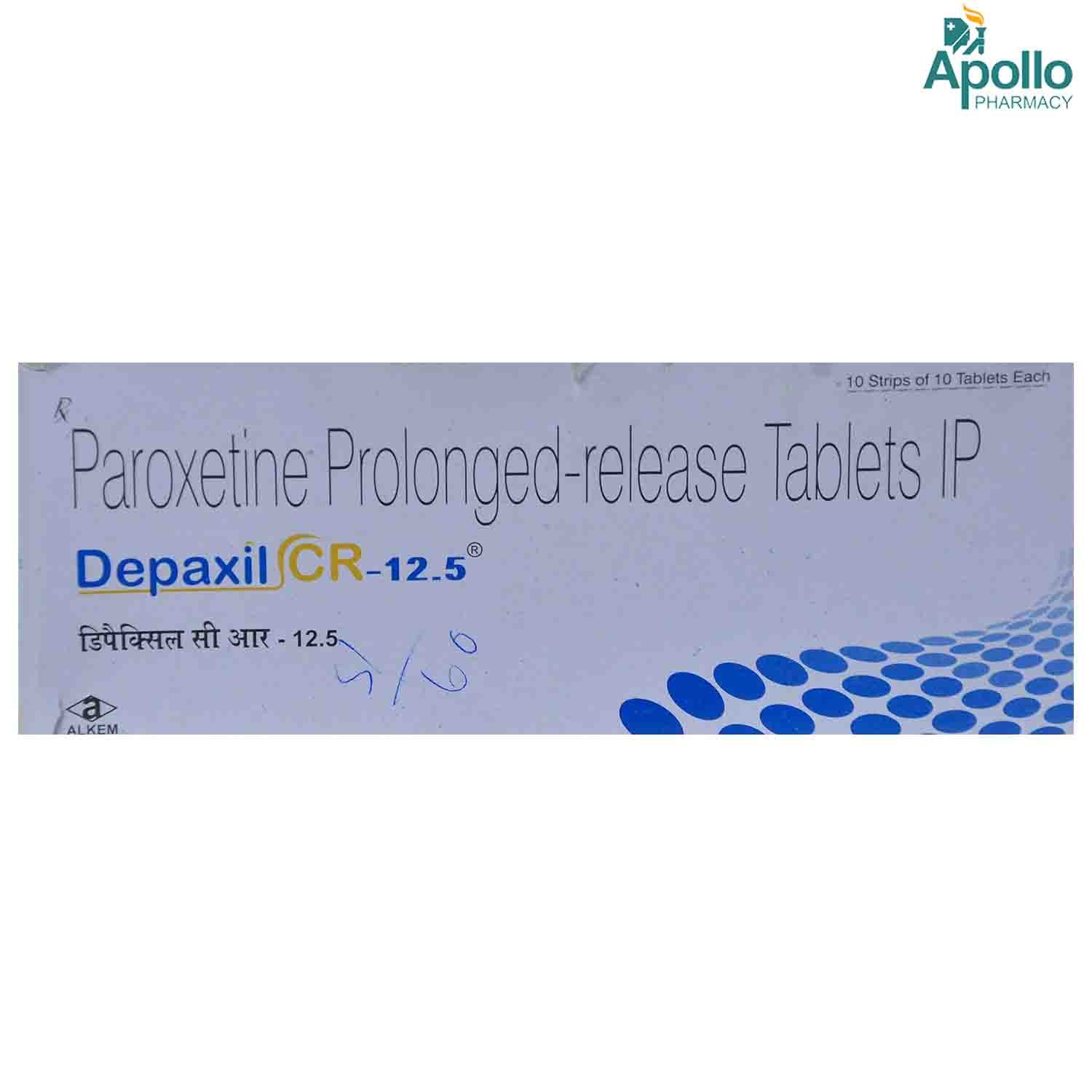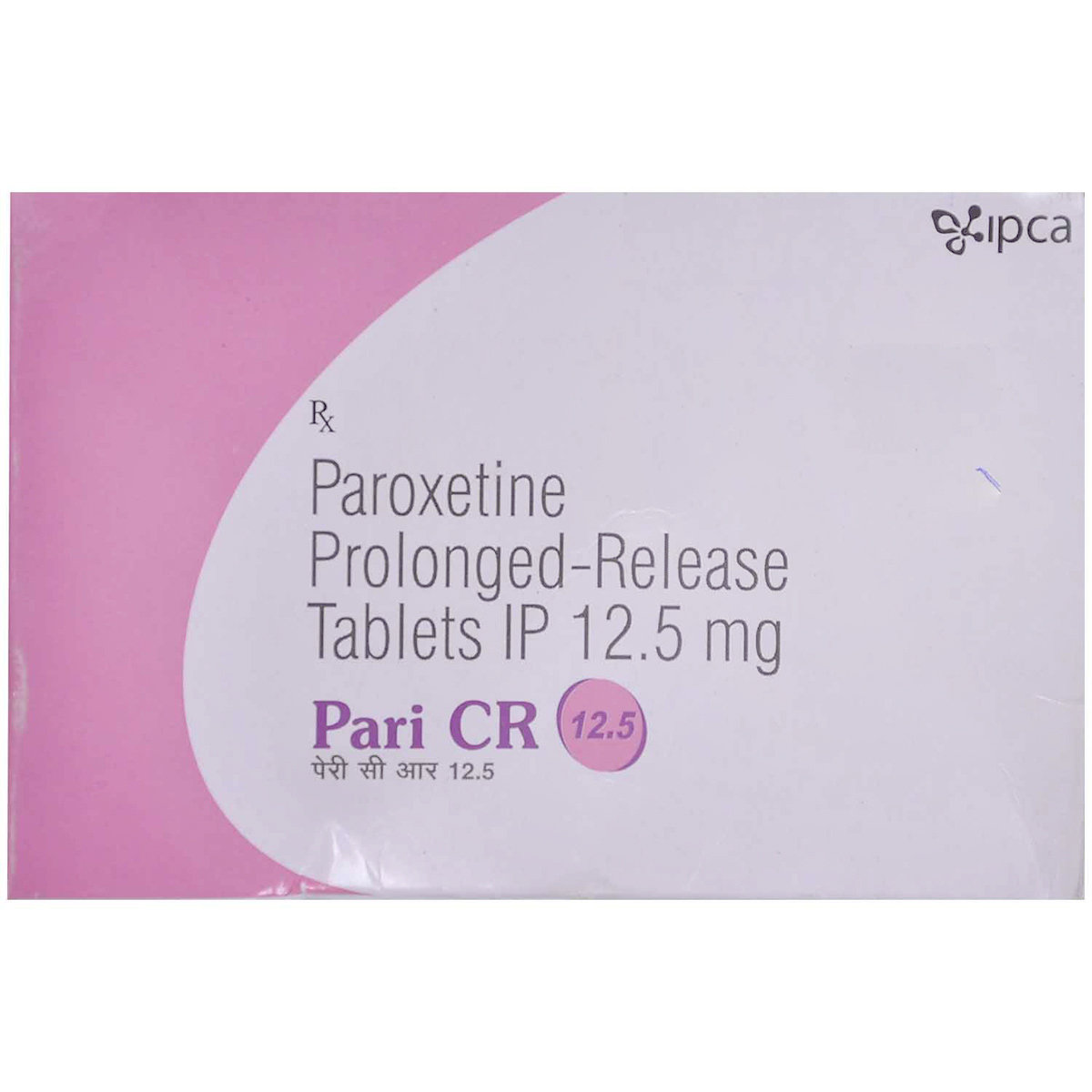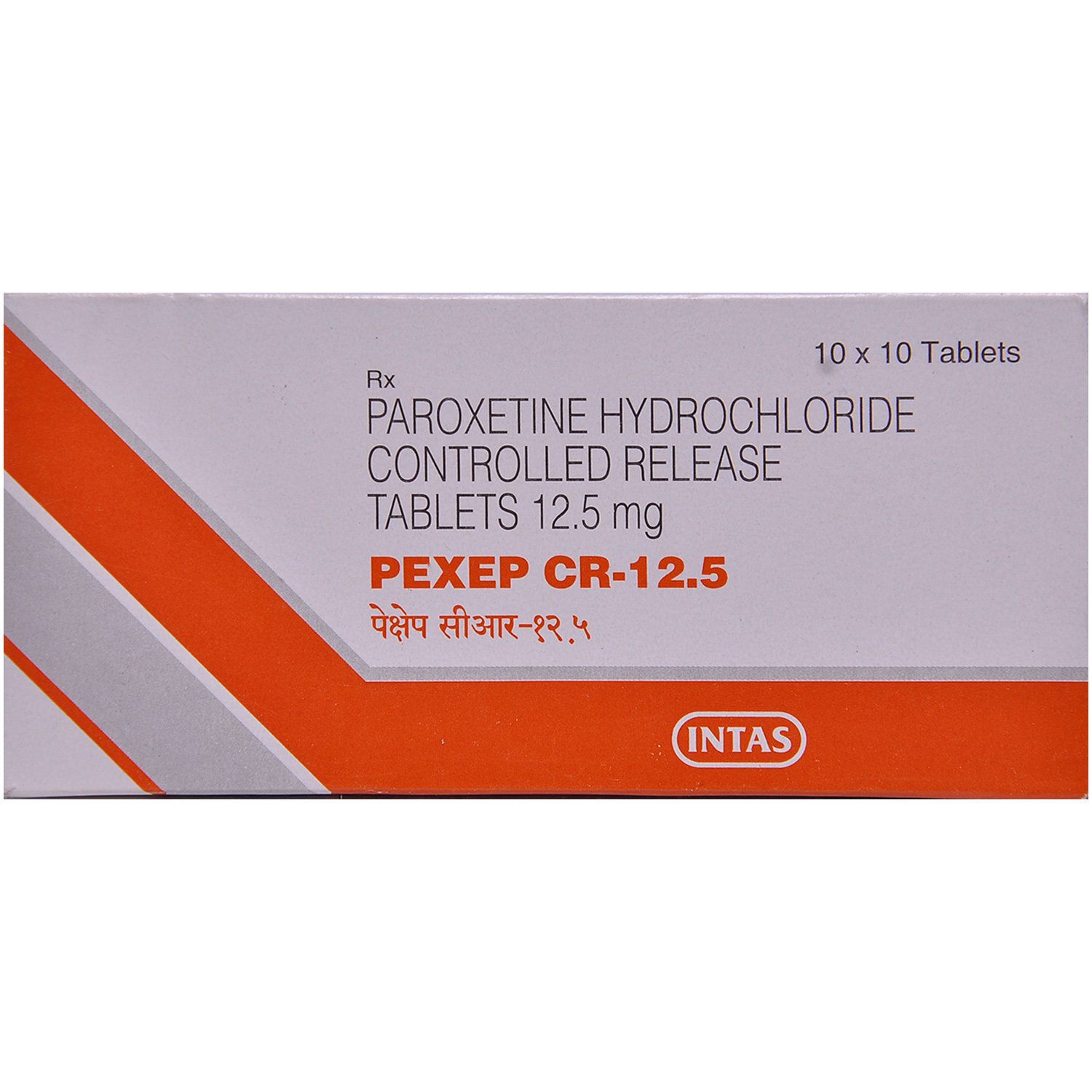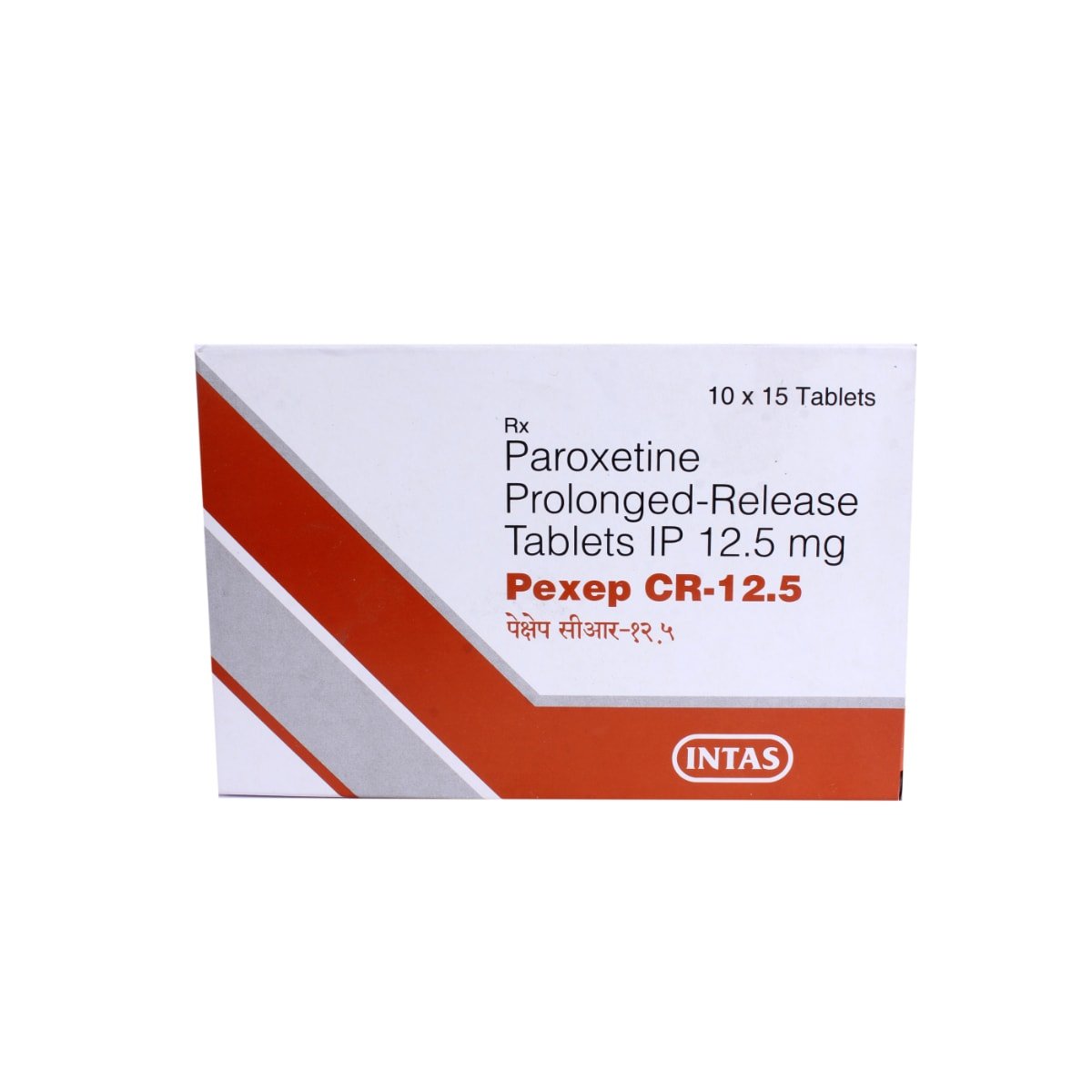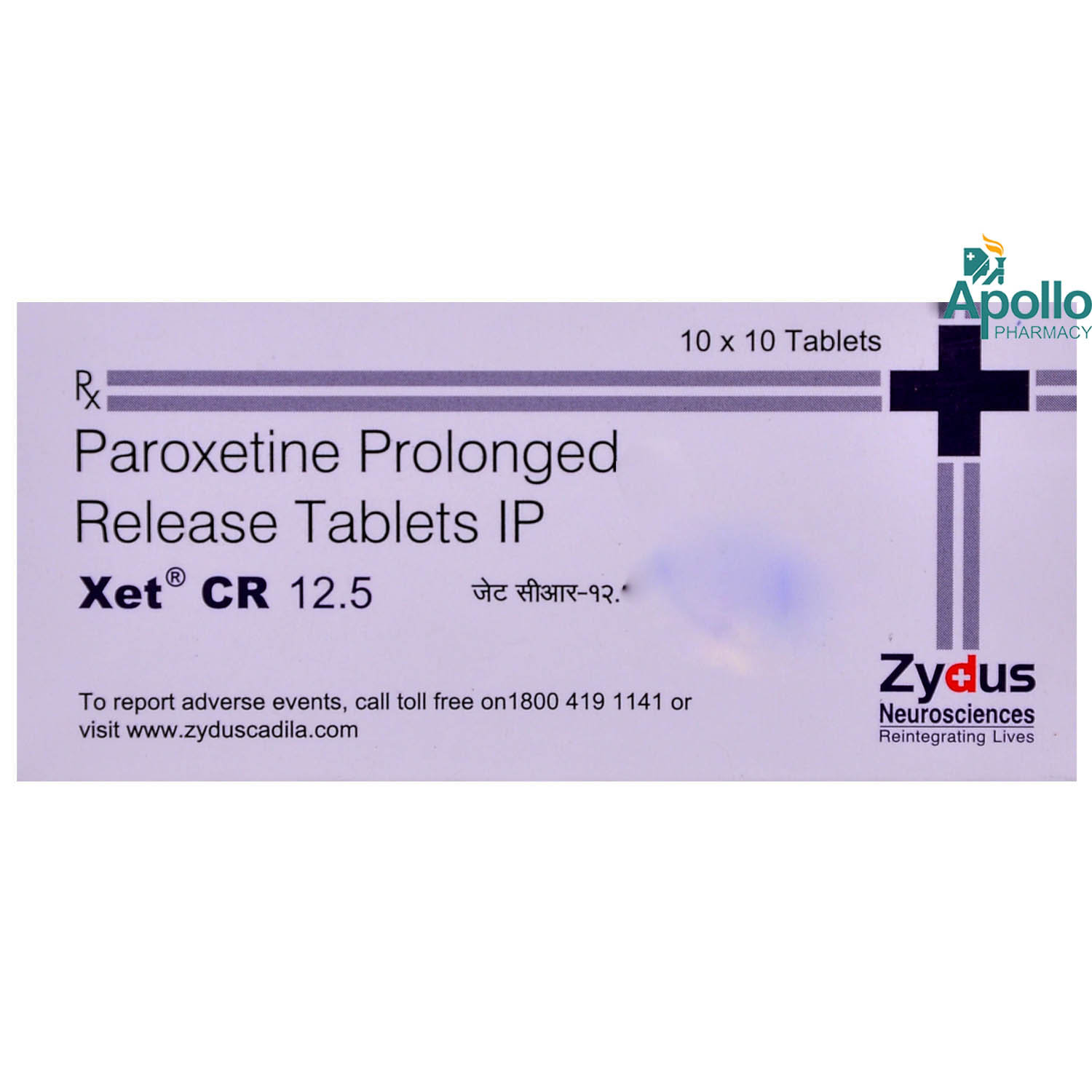Paxi-CR-12.5 Tablet


MRP ₹154.5
(Inclusive of all Taxes)
₹23.2 Cashback (15%)
know your delivery time
Provide Delivery Location
Composition :
Manufacturer/Marketer :
Consume Type :
Expires on or after :
Return Policy :

Secure Payment

Trusted by 8 Crore Indians

Genuine Products
Therapeutic Class
Country of origin
Manufacturer/Marketer address
Author Details
We provide you with authentic, trustworthy and relevant information
Disclaimer
Alcohol
Safe if prescribed
Avoid consumption of alcohol while taking Paxi-CR-12.5 Tablet as it may make your symptoms or side-effects worse.
Pregnancy
Consult your doctor
Paxi-CR-12.5 Tablet belongs to pregnancy category D. It is not recommended to take Paxi-CR-12.5 Tablet if you are pregnant or planning for pregnancy as Paxi-CR-12.5 Tablet might cause foetal harm.
Breast Feeding
Consult your doctor
Paxi-CR-12.5 Tablet may pass into breastmilk. Consult your doctor before taking Paxi-CR-12.5 Tablet ; your doctor will decide whether Paxi-CR-12.5 Tablet can be taken by breastfeeding mothers or not.
Driving
Safe if prescribed
Avoid driving or operating machinery as Paxi-CR-12.5 Tablet may cause dizziness, confusion, sleepiness and blurred vision.
Liver
Consult your doctor
Dose adjustment may be needed in patients with liver impairment. Please consult your doctor if you have a liver impairment or any concerns regarding this.
Kidney
Consult your doctor
Dose adjustment may be needed in patients with kidney impairment. Please consult your doctor if you have kidney impairment or any concerns regarding this.
Children
Safe if prescribed
Paxi-CR-12.5 Tablet is not recommended for children below 18 years as the safety and effectiveness have not been established.
Product Substitutes
About Paxi-CR-12.5 Tablet
Paxi-CR-12.5 Tablet belongs to a group of medicines called antidepressants used to treat a major depressive disorder, obsessive-compulsive disorder (OCD), panic disorder, social anxiety disorder, post-traumatic stress disorder, premenstrual dysphoria disorder and generalised anxiety disorder. Depression is a mood disorder characterised by sadness, unhappiness, anger, hopelessness or loss that interferes with a person’s daily activities.
Paxi-CR-12.5 Tablet contains ‘Paroxetine’, which is a selective serotonin reuptake inhibitor. It works by inhibiting serotonin's reuptake, a mood-enhancing chemical messenger in the brain that communicates between brain cells. This helps increase serotonin concentrations in the nerve synapse, thereby regulating mood and treating depression and anxiety disorders.
Take Paxi-CR-12.5 Tablet as prescribed. You are advised to take Paxi-CR-12.5 Tablet for as long as your doctor has prescribed it for you depending on your medical condition and response to the treatment. In some cases, you may experience certain common side-effects such as insomnia (difficulty sleeping), dizziness, headache, diarrhoea, nausea, fatigue, dry mouth, loss of appetite, and sexual disturbances. You are advised to talk to your doctor if the side effects persist or worsen.
Do not take Paxi-CR-12.5 Tablet if you are pregnant, as it may cause harm to the foetus. Consult your doctor before taking Paxi-CR-12.5 Tablet if you are breastfeeding. Avoid driving or operating machinery as Paxi-CR-12.5 Tablet may cause dizziness, confusion, sleepiness and blurred vision. Paxi-CR-12.5 Tablet is not recommended for children below 18 years as the safety and effectiveness have not been established. Avoid consumption of alcohol while taking Paxi-CR-12.5 Tablet as it may make your symptoms or side-effects worse. Keep your doctor informed about your health condition and medicines to rule out any side-effects.
Uses of Paxi-CR-12.5 Tablet
Medicinal Benefits Mweb
Key Benefits
Paxi-CR-12.5 Tablet belongs to a group of antidepressant medicines called selective serotonin reuptake inhibitors. Paxi-CR-12.5 Tablet is used to treat major depressive disorder, obsessive-compulsive disorder (OCD), panic disorder, social anxiety disorder, post-traumatic stress disorder, premenstrual dysphoric disorder, and generalised anxiety disorder. Paxi-CR-12.5 Tablet works by inhibiting serotonin's reuptake by nerves, a mood-enhancing chemical messenger in the brain that communicates between brain cells. This helps increase serotonin concentrations in the nerve synapse, thereby regulating mood and treating depression and anxiety disorders. Paxi-CR-12.5 Tablet has fewer unwanted side effects than older antidepressants and helps people recover from depression.
Directions for Use
Side Effects of Paxi-CR-12.5 Tablet
- Insomnia (difficulty sleeping)
- Headache
- Diarrhoea
- Nausea
- Fatigue
- Dry mouth
- Loss of appetite
- Sexual disturbances
Drug Warnings
Do not take Paxi-CR-12.5 Tablet if you are allergic to any of its contents; if you are taking monoamine oxidase inhibitors (MAOI) or have taken them in the last 14 days, or if you are taking antipsychotic medicines such as thioridazine or pimozide. Consult your doctor immediately if you have suicidal thoughts, such as killing or harming yourself. Inform your doctor if you have/had epilepsy, mania, diabetes, low sodium levels in blood, glaucoma, or are undergoing treatment for severe depression called electro-convulsive therapy. Do not take Paxi-CR-12.5 Tablet if you are pregnant, as it may cause harm to the foetus. Consult your doctor before taking Paxi-CR-12.5 Tablet if you are breastfeeding. Avoid driving or operating machinery as Paxi-CR-12.5 Tablet may cause dizziness, confusion, sleepiness and blurred vision. Paxi-CR-12.5 Tablet is not recommended for children below 18 years as the safety and effectiveness have not been established. Avoid consumption of alcohol while taking Paxi-CR-12.5 Tablet as it may make your symptoms or side-effects worse.
Drug-Drug Interactions
Drug-Drug Interactions
Login/Sign Up
Taking Furazolidone with Paxi-CR-12.5 Tablet can increase the risk of side effects
How to manage the interaction:
Taking Paxi-CR-12.5 Tablet with Furazolidone is not recommended, but should be taken if advised by a doctor. However, if you experience confusion, hallucination, seizure, increased heart rate, fever, excessive sweating, shivering or shaking, or blurred vision contact your doctor immediately. Do not discontinue any medications without consulting a doctor.
Using tranylcypromine with Paxi-CR-12.5 Tablet can increase the risk of side effects.
How to manage the interaction:
Taking Paxi-CR-12.5 Tablet with Tranylcypromine is not recommended, but should be taken if advised by a doctor. However, if you experience dizziness, lightheadedness, fainting, shortness of breath, or heart palpitations contact your doctor immediately. Do not discontinue any medications without consulting a doctor.
Coadministration of Paxi-CR-12.5 Tablet with Thioridazine can increase the risk of irregular heart rhythm.
How to manage the interaction:
Taking Thioridazine with Paxi-CR-12.5 Tablet is not recommended, but should be taken if advised by a doctor. However, if you experience sudden dizziness, lightheadedness, fainting, shortness of breath, or heart palpitations contact your doctor immediately. Do not discontinue any medications without consulting a doctor.
Using Metoclopramide with Paxi-CR-12.5 Tablet can cause serotonin syndrome. Serotonin syndrome is a condition in which a chemical called serotonin builds up in your body, causing signs and symptoms ranging from mild (shivering and diarrhoea) to severe (muscle rigidity, fever, and seizures).
How to manage the interaction:
Taking Metoclopramide with Paxi-CR-12.5 Tablet is not recommended, as it can possibly lead to an interaction, it can be taken if prescribed by your doctor. Do not stop using any medications without a doctor’s advice.
When Paxi-CR-12.5 Tablet is taken with Selegiline, may increase the risk of serotonin syndrome (a condition in which a chemical called serotonin increases in your body).
How to manage the interaction:
Taking Paxi-CR-12.5 Tablet with Selegiline can possibly lead to an interaction but it can be taken if your doctor has advised it. If you notice any of these symptoms like confusion, hallucination, seizure, increased heart rate, fever, excessive sweating, shivering or shaking, blurred vision, muscle spasm or stiffness, tremor, incoordination, stomach cramps, nausea, vomiting, diarrhea, contact your doctor immediately. Do not discontinue any medications without consulting your doctor.
Using phenelzine with Paxi-CR-12.5 Tablet can increase the risk of side effects.
How to manage the interaction:
Taking Paxi-CR-12.5 Tablet with Phenelzine is not recommended, but should be taken if advised by a doctor. However, if you experience confusion, hallucination, seizure, increased heart rate, fever, excessive sweating, shivering or shaking, or blurred vision contact your doctor immediately. Do not discontinue any medications without consulting a doctor.
Using procarbazine together with Paxi-CR-12.5 Tablet can increase the risk of a serious condition called the serotonin syndrome(a condition in which a chemical called serotonin increase in your body).
How to manage the interaction:
Taking Paxi-CR-12.5 Tablet with Procarbazine is not recommended, but should be taken if advised by a doctor. However, if you experience confusion, hallucination, seizure, increased heart rate, fever, excessive sweating, shivering or shaking, or blurred vision contact your doctor immediately. Do not discontinue any medications without consulting a doctor.
Using Linezolid together with Paxi-CR-12.5 Tablet can increase the risk of a serious condition called serotonin syndrome (A condition resulting from the accumulation of high levels of serotonin in the body. Serotonin is a chemical that plays a role in overall wellbeing and especially a mood stabilizer).
How to manage the interaction:
Taking Paxi-CR-12.5 Tablet with Linezolid is not recommended but should be taken if advised by a doctor. However, if you experience confusion, hallucination, seizure, extreme changes in blood pressure, increased heart rate, fever, excessive sweating, shivering or shaking, blurred vision contact a doctor immediately. Do not discontinue any medications without consulting a doctor.
Using isocarboxazid with Paxi-CR-12.5 Tablet can increase the risk of side effects.
How to manage the interaction:
Taking Paxi-CR-12.5 Tablet with Isocarboxazid is not recommended, but should be taken if advised by a doctor. However, if you experience confusion, hallucination, seizure, extreme changes in blood pressure, increased heart rate, fever, excessive sweating, shivering or shaking, blurred vision contact your doctor immediately. Do not discontinue any medications without consulting a doctor.
Combining Paxi-CR-12.5 Tablet with Pimozide can effect the rhythm of the heart
How to manage the interaction:
Taking Paxi-CR-12.5 Tablet with Pimozide is not recommended, but should be taken if advised by a doctor. However, if you experience chest tightness, irregular heartbeat, blurred vision and nausea contact your doctor immediately. Do not discontinue any medications without consulting a doctor.
Drug-Food Interactions
Drug-Food Interactions
Login/Sign Up
Drug-Diseases Interactions
Drug-Diseases Interactions
Login/Sign Up
Drug-Drug Interactions Checker List
- WARFARIN
- CLOPIDOGREL
- PERPHENAZINE
- THIORIDAZINE
- CLOZAPINE
- LITHIUM
- RISPERIDONE
- CLOMIPRAMINE
- MOCLOBEMIDE
- METHYLENE BLUE
- NORTRIPTYLINE
- DESIPRAMINE
- ASPIRIN
- IBUPROFEN
- CELECOXIB
- ETODOLAC
- DICLOFENAC
- MELOXICAM
- TRAMADOL
- PETHIDINE
- TAMOXIFEN
- SUMATRIPTAN
- FENTANYL
- RITONAVIR
- PHENOBARBITAL
- PHENYTOIN
- CARBAMAZEPINE
- PROPAFENONE
- FLECAINIDE
- METOPROLOL
- RIFAMPICIN
- LINEZOLID
- PRAVASTATIN
- MIVACURIUM
- ATOMOXETINE
- PROCYCLIDINE
- TRYPTOPHAN
- FOSAMPRENAVIR
- SUXAMETHONIUM
Habit Forming
Special Advise
- Close monitoring of patients taking Paxi-CR-12.5 Tablet for suicidal behaviour is advised. Talk to your doctor immediately if you have thoughts of harming or killing yourself.
Diet & Lifestyle Advise
- Maintain a healthy diet and exercise regularly as it helps in improving overall health and boosts self-esteem.
- Regularly attend therapy sessions.
- Perform meditation and yoga. This helps in relieving stress and provides relaxation.
- Follow a regular sleep pattern to improve the amount and quality of sleep you get.
- Include foods rich in omega fatty acids such as fish, nuts, fresh fruits, vegetables and olive oils.
- Neurotransmitters are made up of amino acids. Amino acid-rich foods such as meat, dairy products, and certain fruits and vegetables help in the proper maintenance of neurotransmitters.
- Complex carbohydrates help in stimulating serotonin (a feel-good neurotransmitter). These include whole grains, legumes, spinach, broccoli, oranges and pears.
- Exercising helps in the production of the body’s natural antidepressants. It also helps in relieving stress, improving mood, boosting self-esteem, and providing restful sleep.
- Avoid smoking and alcohol consumption.
- Learn about your condition, understand the risk factors and follow the doctor’s treatment plan.
All Substitutes & Brand Comparisons
RX
Paro Cr 12.5mg Tablet 10's
D D Pharmaceuticals Pvt Ltd
₹128
(₹11.52 per unit)
17% CHEAPERRX
Pariwave CR 12.5 Tablet 10's
Brainwave Healthcare Pvt Ltd
₹150
(₹13.5 per unit)
2% CHEAPERRX
Pexpen CR 12.5 Tablet 10's
Aspen Pharmaceutical Pvt Ltd
₹160
(₹14.4 per unit)
3% COSTLIER

Have a query?
Buy best C.n.s Drugs products by
Intas Pharmaceuticals Ltd
Sun Pharmaceutical Industries Ltd
Torrent Pharmaceuticals Ltd
Alkem Laboratories Ltd
Abbott India Ltd
Cipla Ltd
Alteus Biogenics Pvt Ltd
Micro Labs Ltd
Lupin Ltd
Ipca Laboratories Ltd
D D Pharmaceuticals Pvt Ltd
Icon Life Sciences
Mankind Pharma Pvt Ltd
Tripada Healthcare Pvt Ltd
Arinna Lifesciences Ltd
Linux Laboratories Pvt Ltd
East West Pharma India Pvt Ltd
La Renon Healthcare Pvt Ltd
Talent India Pvt Ltd
Tas Med India Pvt Ltd
Zydus Healthcare Ltd
Cnx Health Care Pvt Ltd
Eris Life Sciences Ltd
Leeford Healthcare Ltd
Emcure Pharmaceuticals Ltd
Macleods Pharmaceuticals Ltd
Sigmund Promedica
Aristo Pharmaceuticals Pvt Ltd
Dr Reddy's Laboratories Ltd
Troikaa Pharmaceuticals Ltd
Consern Pharma Ltd
Zydus Cadila
Shine Pharmaceuticals Ltd
Wockhardt Ltd
Ardent Life Sciences Pvt Ltd
Crescent Formulations Pvt Ltd
Theo Pharma Pvt Ltd
Reliance Formulation Pvt Ltd
Ikon Pharmaceuticals Pvt Ltd
Propel Healthcare
Neon Laboratories Ltd
Jagsam Pharma
Msn Laboratories Pvt Ltd
Morepen Laboratories Ltd
Pulse Pharmaceuticals
Sanofi India Ltd
Med Manor Organics Pvt Ltd
Hetero Healthcare Pvt Ltd
Novartis India Ltd
Crescent Therapeutics Ltd
Elder Pharmaceuticals Ltd
Solvate Laboratories Pvt Ltd
Akumentis Healthcare Ltd
Mova Pharmaceutical Pvt Ltd
Psyco Remedies Ltd
Tripada Lifecare Pvt Ltd
Ajanta Pharma Ltd
Cyrus Remedies Pvt Ltd
Medishri Healthcare Pvt Ltd
Cadila Healthcare Ltd
Glenmark Pharmaceuticals Ltd
Matteo Health Care Pvt Ltd
Hbc Life Sciences Pvt Ltd
Lyf Healthcare
Matias Healthcare Pvt Ltd
Mesmer Pharmaceuticals
Alembic Pharmaceuticals Ltd
Capital Pharma
Crescent Pharmaceuticals
Medopharm Pvt Ltd
Alniche Life Sciences Pvt Ltd
Kivi Labs Ltd
Talin Remedies Pvt Ltd
USV Pvt Ltd
Quince Lifesciences Pvt Ltd
Solis Pharmaceuticals
Infivis Life Care
Zuventus Healthcare Ltd
Cadila Pharmaceuticals Ltd
Pfizer Ltd
Wallace Pharmaceuticals Pvt Ltd
A N Pharmacia Laboratories Pvt Ltd
Blue Cross Laboratories Pvt Ltd
Jenburkt Pharmaceuticals Ltd
Lia Life Sciences Pvt Ltd
Mano Pharma
Medley Pharmaceuticals Ltd
Primus Remedies Pvt Ltd
FDC Ltd
Maneesh Pharmaceuticals Ltd
Apex Laboratories Pvt Ltd
Gagnant Healthcare Pvt Ltd
Ozone Pharmaceuticals Ltd
RPG Life Sciences Ltd
Strides Shasun Ltd
Unichem International
GlaxoSmithKline Pharmaceuticals Ltd
Kuresys Labs Pvt Ltd
LA Pharma
Trion Pharma India Llp

_0.jpg?tr=q-85)

